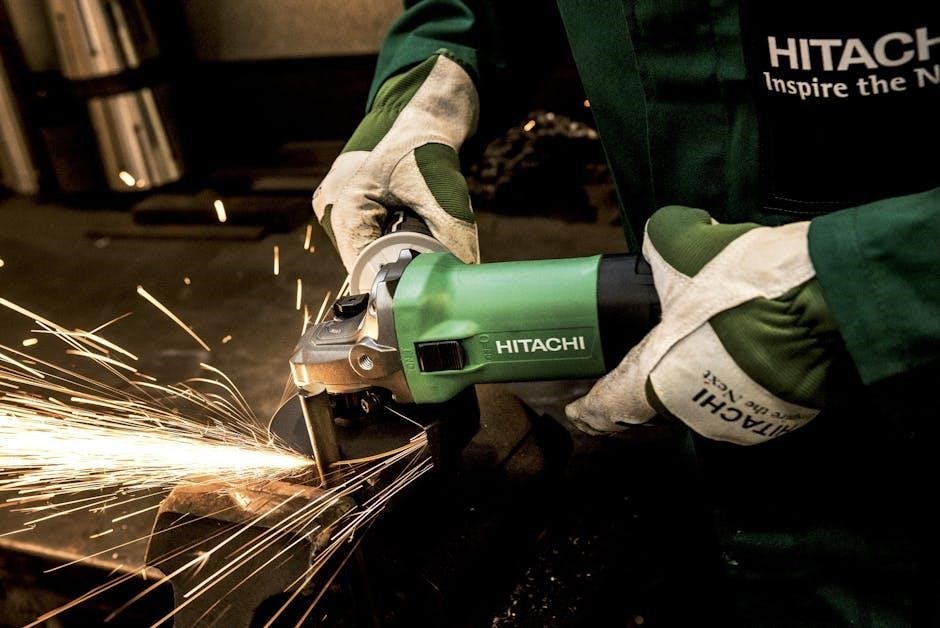The Hitachi WJ200 Series is a versatile and innovative inverter designed for efficient motor control․ With models covering motor sizes from 1/8 to 20 horsepower and various voltage options, it ensures optimal performance and energy efficiency․
1․1 Overview of the Hitachi WJ200 Inverter
The Hitachi WJ200 Series inverter is a high-performance motor control solution designed for versatility and efficiency․ It supports a wide range of motor sizes, from 1/8 to 20 horsepower, and offers multiple voltage options, including 120VAC, 240VAC, and 480VAC․ This flexibility makes it suitable for various industrial and commercial applications․ The inverter is engineered to provide precise speed control, reducing energy consumption and enhancing operational efficiency․ Its compact design and user-friendly interface simplify installation and operation․ The WJ200 Series also features advanced safety measures, such as warning labels and detailed instructions in the manual, ensuring safe and proper usage․ By adhering to the guidelines in the manual, users can optimize performance and extend the lifespan of their equipment․ This overview highlights the key attributes of the WJ200 inverter, emphasizing its reliability and adaptability for diverse applications․

Safety Guidelines and Precautions
Adhering to safety guidelines is crucial when handling the Hitachi WJ200 inverter․ Always read the manual thoroughly and understand safety cautions before operation․ Verify product labels match your power source and application requirements for safe usage․
2․1 Important Safety Information
The Hitachi WJ200 inverter requires careful handling to ensure safe operation․ Always read the instruction manual thoroughly before installation and operation․ Understanding the safety cautions is essential to prevent accidents and ensure proper usage․ The product labels, located on the right side of the housing, provide critical specifications that must match your power source and application requirements․ Failure to comply with these specifications can lead to unsafe conditions․ Additionally, ensure all warning labels are followed meticulously․ Never attempt to install or operate the inverter without proper training or knowledge․ Always disconnect the power supply before performing any maintenance or repairs․ Improper wiring or installation can result in electrical hazards or equipment damage․ By adhering to these safety guidelines, you can ensure the inverter operates efficiently and safely․ Remember, safety should always be your top priority when working with electrical devices like the Hitachi WJ200․
2․2 Product Labels and Their Significance
The product labels on the Hitachi WJ200 inverter are crucial for ensuring safe and proper installation․ These labels are located on the right side of the housing and contain essential specifications that must be verified before use․ They provide detailed information about the inverter’s voltage, power ratings, and other critical operational parameters․ Matching these specifications to your power source and application requirements is essential to avoid hazards and ensure compatibility․ Failure to comply with the information on the labels can lead to unsafe operating conditions, damage to the equipment, or even electrical hazards․ Always inspect the labels carefully and cross-reference them with your system’s requirements․ The labels also highlight important safety warnings and guidelines that must be followed during installation and operation․ By adhering to the information provided on the product labels, you can ensure the Hitachi WJ200 inverter functions safely and efficiently․ Proper verification of these labels is a cornerstone of responsible and safe equipment usage․

Product Specifications and Models
The Hitachi WJ200 series offers a range of models tailored to diverse industrial applications․ Each model is designed to meet specific power and control requirements, ensuring optimal performance across various operational demands․ Compatible with multiple motor types and systems, these inverters provide flexible solutions for industrial automation needs, while maintaining high efficiency and reliability․
3․1 Key Features of the WJ200 Series
The Hitachi WJ200 series is renowned for its high-performance and reliable operation, making it a preferred choice for industrial applications․ One of its standout features is the advanced vector control technology, which ensures precise motor control and high torque accuracy․ The series also boasts a compact and lightweight design, enabling easy installation in confined spaces․ Additionally, the WJ200 inverters are equipped with high-efficiency power-saving technologies, reducing energy consumption while maintaining operational excellence․
Another key feature is the customizable parameters, allowing users to tailor the inverter’s performance to specific applications․ The series also supports built-in PLC (Programmable Logic Controller) functions, enabling advanced automation and control capabilities․ Furthermore, the WJ200 inverters are designed with user-friendly interfaces, including a high-resolution LCD display and intuitive navigation for easy monitoring and adjustments․ These features make the WJ200 series a versatile and efficient solution for a wide range of industrial automation needs․
3․2 Motor Size and Voltage Options
The Hitachi WJ200 series offers a wide range of motor size and voltage options to cater to diverse industrial applications․ The inverters are compatible with various motor sizes, ensuring flexibility and scalability for different operational requirements․ Voltage options include 200V, 400V, and 600V, allowing users to select the most suitable configuration for their systems․ This versatility makes the WJ200 series ideal for applications ranging from small-scale machinery to large industrial plants․
The series also supports both single-phase and three-phase power supplies, further enhancing its adaptability․ Additionally, the inverters are designed to handle a broad power range, from low to high horsepower motors, ensuring seamless integration with existing machinery․ This flexibility in motor size and voltage options enables users to optimize their systems for efficiency and performance․ The WJ200 series is tailored to meet the specific needs of various industries, making it a reliable choice for motor control applications․

Installation and Setup
Proper installation and setup of the Hitachi WJ200 inverter are crucial for optimal performance․ Ensure the unit is mounted securely in a well-ventilated area, away from direct sunlight and moisture․
Follow the manual’s guidelines for wiring and power supply connections to avoid damage or malfunction․ Conduct a thorough inspection before powering up the system․
Test the inverter’s functionality under no-load conditions to confirm proper operation․ Always refer to the manual for specific installation requirements and safety precautions to ensure a safe and efficient setup process․
4․1 Pre-Installation Requirements
Before installing the Hitachi WJ200 inverter, ensure the environment meets specific conditions․ The installation site must be clean, dry, and free from corrosive gases or explosive atmospheres․
Verify that the power supply matches the inverter’s voltage and frequency ratings․ Check the motor specifications to ensure compatibility with the WJ200 series․
Prepare a stable and level surface for mounting the inverter, ensuring proper ventilation to prevent overheating․
Review the manual to confirm all necessary tools and materials are available․
Ensure that the system’s grounding is correctly configured to meet safety standards․
Finally, double-check the wiring diagram and parameter settings to align with the application requirements․ Proper preparation ensures a smooth and safe installation process․
4․2 Wiring and Electrical Connections
Proper wiring and electrical connections are crucial for the safe and efficient operation of the Hitachi WJ200 inverter․ Always use wires of the correct gauge to ensure reliable power transmission and to prevent overheating․
Follow the wiring diagram provided in the manual to connect the input power supply, motor, and control circuits accurately․ Secure all connections tightly to avoid loose contacts, which can cause malfunctions or electrical hazards;
Ensure the ground wire is properly connected to the designated terminal on the inverter to maintain safety and prevent damage from voltage spikes․
Before powering up the system, double-check all connections for accuracy and integrity․ Use appropriate protective equipment when handling live electrical components․
Additionally, ensure that the motor and load are correctly matched to the inverter’s output specifications to avoid overloading or underperformance․
Finally, verify that all electrical connections comply with local safety standards and regulations for industrial equipment․

Operational Parameters
The Hitachi WJ200 operates within specified input and output ratings, ensuring optimal performance․ It supports a wide frequency range and voltage levels, adapting to various motor control applications․ Environmental factors like temperature and humidity must be within recommended limits for reliable operation․
5․1 Understanding Input and Output Ratings
The Hitachi WJ200 inverter is designed to operate within specific input and output ratings to ensure safe and efficient performance․ The input ratings typically include voltage, current, and frequency, while the output ratings define the maximum voltage, current, and power the inverter can supply to the motor․ These ratings are crucial for selecting the correct model for your application and preventing overload or damage․
For the WJ200 series, the input voltage range is generally 200-240V AC or 380-480V AC, depending on the model, while the output frequency can vary from 0 to 400 Hz․ The output current is matched to the motor’s specifications to ensure smooth operation․ Exceeding these ratings can lead to overheating, reduced lifespan, or even system failure․
Always refer to the product manual for precise ratings and ensure the inverter is configured correctly for your motor and application․ Proper alignment of input and output ratings is essential for optimal performance and reliability․

Advanced Features and Functionalities
The Hitachi WJ200 series offers advanced features like vector control, multi-speed operation, and PLC connectivity․ It supports real-time monitoring and customizable settings, ensuring precise motor control and enhanced productivity for industrial applications․
6․1 Customizable Parameters for Enhanced Control
The Hitachi WJ200 series provides a wide range of customizable parameters to optimize motor control and adapt to specific application requirements․ Users can adjust settings such as acceleration and deceleration times, torque limits, and frequency ranges to achieve precise performance; These parameters can be tailored to match the exact needs of the connected machinery, ensuring smooth operation and reducing mechanical stress․ Additionally, the inverter supports advanced functionalities like automatic torque boost, slip compensation, and speed search, which enhance control accuracy and responsiveness․ The WJ200 also allows customization of input/output signals, enabling seamless integration with external control systems․ By leveraging these features, users can maximize efficiency, reduce energy consumption, and extend equipment lifespan․ The Hitachi WJ200 manual provides detailed guidance on configuring these parameters, ensuring optimal setup for diverse industrial applications․ This level of customization makes the WJ200 series highly versatile and suitable for complex automation environments․

Maintenance and Troubleshooting

Regular maintenance ensures optimal performance and longevity of the Hitachi WJ200․ Clean the inverter, inspect connections, and check for wear․ Address issues promptly to prevent downtime․ Refer to the manual for troubleshooting guidelines․
7․1 Regular Maintenance Tips
Regular maintenance is crucial for ensuring the Hitachi WJ200 inverter operates efficiently and reliably․ Start by cleaning the unit to remove dust and debris, which can cause overheating․ Inspect all electrical connections for tightness and signs of wear․ Check the cooling fans for proper operation and ensure good airflow around the inverter․ Replace any worn-out parts immediately to prevent malfunctions․ Additionally, review the parameter settings periodically to ensure they align with your application requirements․ Update the firmware if necessary, as newer versions may offer improved performance or bug fixes․ Always refer to the Hitachi WJ200 manual for detailed maintenance procedures and guidelines․ Regular checks can help identify potential issues early, reducing downtime and extending the lifespan of the inverter․ By following these tips, you can maintain optimal performance and ensure the WJ200 continues to meet your operational needs effectively․
- Clean the inverter regularly to prevent dust buildup․
- Inspect electrical connections for tightness and damage․
- Ensure proper ventilation and cooling fan operation․
- Update firmware and parameters as needed․
- Refer to the manual for specific maintenance instructions․
7․2 Common Issues and Solutions
The Hitachi WJ200 inverter is a reliable device, but like any complex equipment, it may encounter issues․ One common problem is the display of error codes, which can indicate overcurrent, overheating, or communication faults․ Refer to the manual for specific code meanings and troubleshooting steps․ Another issue is unexpected shutdowns, often caused by power supply fluctuations or improper parameter settings․ Adjusting the voltage and frequency parameters according to the application can resolve this․ Additionally, improper wiring or loose connections may lead to malfunctions․ Inspecting and tightening all connections can prevent such problems․ If the inverter fails to start, check the input power supply and ensure all safety devices are functioning properly․ For persistent issues, upgrading the firmware or consulting a qualified technician is recommended․ Regularly reviewing the Hitachi WJ200 manual ensures familiarity with troubleshooting procedures and optimal operation․
- Error codes: Refer to the manual for specific solutions․
- Unexpected shutdowns: Check power supply and parameter settings․
- Malfunctions: Inspect wiring and connections․
- Failure to start: Verify input power and safety devices․
- Persistent issues: Upgrade firmware or consult a technician․

Downloading the Hitachi WJ200 Manual
To download the Hitachi WJ200 manual, visit the official Hitachi website․ Navigate to the product support section, select the WJ200 series, and choose the appropriate manual for your model․ Follow the on-screen instructions to complete the download․ Ensure you have the correct model number for accurate documentation․ If prompted, register or log in to access the PDF․ For any issues, contact Hitachi support for assistance․
8․1 Steps to Access the PDF Manual
To access the Hitachi WJ200 manual in PDF format, follow these organized steps:
- Visit the official Hitachi website at https://www․hitachi․com․
- Navigate to the “Support” or “Downloads” section, typically found in the top menu․
- Scroll down or use the search bar to locate the “WJ200 Series” or “Inverters” category․
- Enter the specific model number of your WJ200 inverter in the search box for precise results․
- Select the appropriate manual from the list of available documents․
- Choose the language and format (PDF) for your download․
- Review and agree to any terms or conditions if prompted․
- Click the “Download” button to initiate the process․
- Save the PDF file to your device for easy access․
- Open the document using a PDF reader to view the manual;

Ensure your internet connection is stable during the download process․ If you encounter issues, contact Hitachi customer support for assistance․
The Hitachi WJ200 Series offers a comprehensive solution for industrial motor control, combining advanced features with user-friendly operation․ This manual provides detailed guidance, ensuring optimal performance and safe usage of the inverter․
9․1 Final Thoughts on the Hitachi WJ200 Series
The Hitachi WJ200 Series is a robust and versatile inverter range designed to meet the demands of modern industrial applications․ Its advanced features, such as customizable parameters and energy-efficient operation, make it a reliable choice for motor control․ The comprehensive manual provides clear guidance, ensuring users can optimize performance and troubleshoot effectively․ With its user-friendly interface and adaptability to various environments, the WJ200 Series stands out as a high-quality solution for industrial automation․ Whether for new installations or upgrades, this inverter series delivers consistent reliability and efficiency, making it a valuable asset for industries seeking precise motor control․ By following the manual’s instructions and maintaining regular upkeep, users can ensure long-term functionality and maximize their investment in this cutting-edge technology․